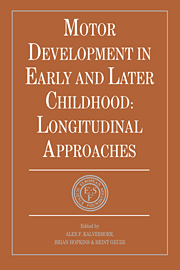Book contents
- Frontmatter
- Contents
- List of contributors
- Foreword
- Preface
- SETTING THE SCENE
- 1 Motor development in children at risk: two decades of research in experimental clinical psychology
- 2 Longitudinal studies in motor development: developmental neurological considerations
- SECTION I BIOLOGICAL BASIS OF MOTOR DEVELOPMENT
- SECTION II DEVELOPMENT OF BODY POSTURE AND GOAL-DIRECTED REACHING
- SECTION III MOTOR DEVELOPMENT, EARLY COMMUNICATION AND COGNITION
- SECTION IV ACQUISITION OF SKILLS
- SECTION V MOTOR DEVELOPMENT AND HANDICAP
- SECTION VI METHODOLOGICAL AND CONCEPTUAL CONSIDERATIONS
- Epilogue: description versus explanation
- Index
1 - Motor development in children at risk: two decades of research in experimental clinical psychology
from SETTING THE SCENE
Published online by Cambridge University Press: 05 May 2010
- Frontmatter
- Contents
- List of contributors
- Foreword
- Preface
- SETTING THE SCENE
- 1 Motor development in children at risk: two decades of research in experimental clinical psychology
- 2 Longitudinal studies in motor development: developmental neurological considerations
- SECTION I BIOLOGICAL BASIS OF MOTOR DEVELOPMENT
- SECTION II DEVELOPMENT OF BODY POSTURE AND GOAL-DIRECTED REACHING
- SECTION III MOTOR DEVELOPMENT, EARLY COMMUNICATION AND COGNITION
- SECTION IV ACQUISITION OF SKILLS
- SECTION V MOTOR DEVELOPMENT AND HANDICAP
- SECTION VI METHODOLOGICAL AND CONCEPTUAL CONSIDERATIONS
- Epilogue: description versus explanation
- Index
Summary
INTRODUCTION
This chapter discusses some core issues in the study of normal and deviant motor development that have been addressed in experimental clinical psychology during the last 20 years. I try to indicate how longitudinal and cross-sectional approaches may be interrelated in interdisciplinary studies on motor development and how ethological observations and information-processing experiments may both have their function in the study of motor development in normal children as well as in children at risk. The following points are discussed:
(1) Why study motor development in the context of research on neurobehavioural relationships?
(2) Is there an optimal strategy in the longitudinal study of motor development? How can an optimal balance be obtained between observation and experiment in research on motor development?
(3) How may intra- and interdisciplinary studies complement each other?
To begin with, I discuss briefly the rationales for studying motor development.
WHY STUDY MOTOR DEVELOPMENT?
Motor development in humans can be studied for at least two reasons (see Kalverboer & Hopkins, 1983).
Motor development studied in its own right
What are the relevant motor phenomena in the various phases of development? How are motor functions controlled (e.g. the role of visual and proprioceptive feedback in movement control) and what are the processes of organization and reorganization during motor development? Previously such studies on motor development per se were of a global and descriptive character (e.g. in terms of milestones or the observation of complex motor performances as made in such tests as the Lincoln–Oseretsky (Sloan, 1955).
- Type
- Chapter
- Information
- Motor Development in Early and Later ChildhoodLongitudinal Approaches, pp. 1 - 14Publisher: Cambridge University PressPrint publication year: 1993



